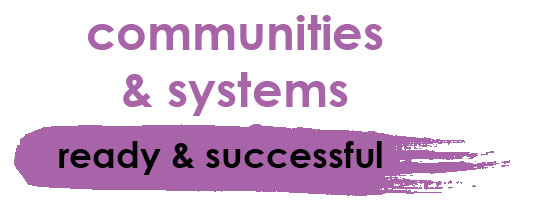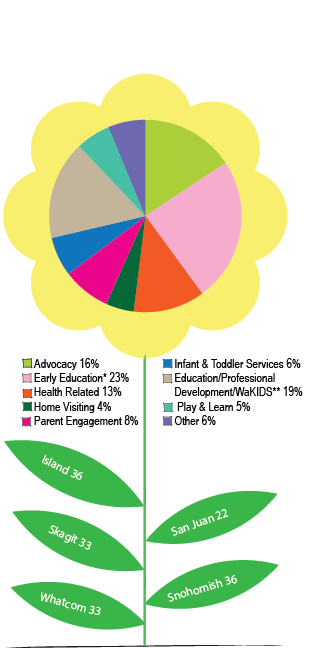Index and Glossary
- Ready & Successful Children
- Ready & Successful Families
- Ready & Successful Professionals
- Ready & Successful Schools
- Ready & Successful Communities & Systems
| Data Indicator | Island | San Juan | Skagit | Snohomish | Whatcom | State |
|---|---|---|---|---|---|---|
| Housing Affordability Ranking 1 | Poor | Poor | Poor | Poor | Poor | N/A |
| Job Opportunities Ranking 2 | Poor | Fair | Good | Good | Fair | N/A |
| Community Resources Ranking 3 | Good | Good | Good | Fair | Fair | N/A |
| Combined households below US poverty and those that earn over poverty level but less than basic cost of living: | ||||||
| Asian households 4 | 37% | 37% | 47% | 31% | 47% | N/A |
| Black households 5 | 48% | 17% | 31% | 45% | 67% | N/A |
| Hispanic households 6 | 37% | 57% | 57% | 47% | 55% | N/A |
| White households 7 | 31% | 31% | 33% | 32% | 39% | N/A |
| Number of partner organizations affiliated with Northwest Early Learning 8 | 36 | 22 | 33 | 36 | 33 | 10 |
| Participants at PreK-K Collaborative Network Dinner & Dialogues, Spring 2016 9 | 58 | 50 | 36 | 74 | 50 | N/A |
| PreK-K Transition Reports shared between preschool and kindergarten teachers 10 | 178^ | 70^ | 274^ | 926^ | 343^ | N/A |
Pre-K Transition Reports
|
Source: Northwest Educational Service District 189, August 2015 |
1 Source: Fall 2015 Pacific Northwest: Idaho, Oregon, and Washington Study of Financial Hardship Economic Viability Dashboard Figure 38, pages 88-89; United Way ALICE Report. Note: ALICE, an acronym for Asset Limited, Income Constrained, Employed, are households that earn more than the U.S. poverty level, but less than the basic cost of living for the county. Combined, the number of poverty and ALICE households equals the total population struggling to afford basic needs.
2 Source: Fall 2015 Pacific Northwest: Idaho, Oregon, and Washington Study of Financial Hardship Economic Viability Dashboard Figure 38, pages 88-89; United Way ALICE Report. Note: ALICE, an acronym for Asset Limited, Income Constrained, Employed, are households that earn more than the U.S. poverty level, but less than the basic cost of living for the county. Combined, the number of poverty and ALICE households equals the total population struggling to afford basic needs.
3 Source: Fall 2015 Pacific Northwest: Idaho, Oregon, and Washington Study of Financial Hardship Economic Viability Dashboard Figure 38, pages 88-89; United Way ALICE Report. Note: ALICE, an acronym for Asset Limited, Income Constrained, Employed, are households that earn more than the U.S. poverty level, but less than the basic cost of living for the county. Combined, the number of poverty and ALICE households equals the total population struggling to afford basic needs.
4 Source: Fall 2015 Pacific Northwest: Idaho, Oregon, and Washington Study of Financial Hardship Economic Viability Dashboard pages 154-155; United Way ALICE Report. Note: ALICE, an acronym for Asset Limited, Income Constrained, Employed, are households that earn more than the U.S. poverty level, but less than the basic cost of living for the county. Combined, the number of poverty and ALICE households equals the total population struggling to afford basic needs.
5 Source: Fall 2015 Pacific Northwest: Idaho, Oregon, and Washington Study of Financial Hardship Economic Viability Dashboard pages 154-155; United Way ALICE Report. Note: ALICE, an acronym for Asset Limited, Income Constrained, Employed, are households that earn more than the U.S. poverty level, but less than the basic cost of living for the county. Combined, the number of poverty and ALICE households equals the total population struggling to afford basic needs.
6 Source: Fall 2015 Pacific Northwest: Idaho, Oregon, and Washington Study of Financial Hardship Economic Viability Dashboard pages 154-155; United Way ALICE Report. Note: ALICE, an acronym for Asset Limited, Income Constrained, Employed, are households that earn more than the U.S. poverty level, but less than the basic cost of living for the county. Combined, the number of poverty and ALICE households equals the total population struggling to afford basic needs.
7 Source: Fall 2015 Pacific Northwest: Idaho, Oregon, and Washington Study of Financial Hardship Economic Viability Dashboard pages 154-155; United Way ALICE Report. Note: ALICE, an acronym for Asset Limited, Income Constrained, Employed, are households that earn more than the U.S. poverty level, but less than the basic cost of living for the county. Combined, the number of poverty and ALICE households equals the total population struggling to afford basic needs.
9 Source: September 2015 PreK-K Collaborative Network, Northwest Educational Service District
10 Source: September 2015 PreK-K Collaborative Network, Northwest Educational Service District


